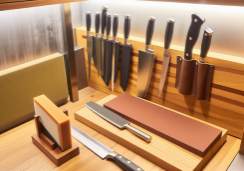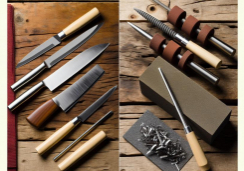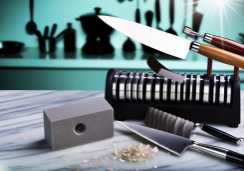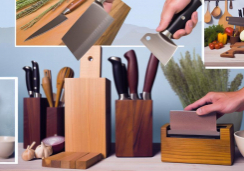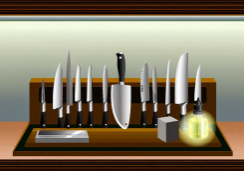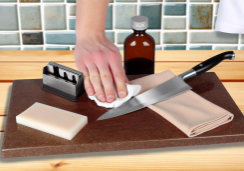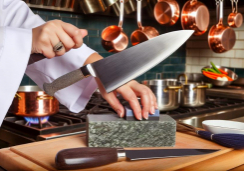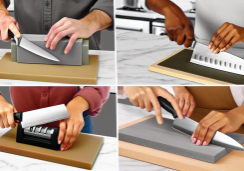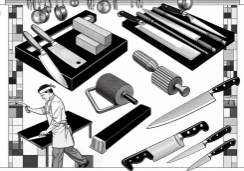Top Knife Sharpening Methods for Culinary Experts
Is it true that a sharp knife is a chef's best friend? You've likely heard this adage tossed around kitchens and culinary forums, often followed by a variety of methods claiming to produce the keenest edge. As a culinary expert, you understand the importance of maintaining your tools, but with the plethora of sharpening techniques available, it can be challenging to discern which will serve you best.
Whether it's the traditional whetstone that requires a practiced hand and patience, the quick and consistent results from an electric sharpener, or the finesse of stropping, each method has its advocates and specific use cases. Your choice can greatly affect the performance of your knives and, in turn, the quality of your work.
Stick around to explore the subtle nuances and find out which sharpening method aligns with your culinary artistry and demands.
Understanding Knife Edge Anatomy
To sharpen your knife effectively, it's essential to grasp the components that constitute the blade's edge, including the bevel, spine, and point.
The bevel, often the misunderstood hero of knife anatomy, is the angled surface that forms the edge. It's critical to maintain this angle consistently while sharpening; otherwise, you'll end up with an uneven edge, impacting your knife's performance.
The spine, the top part of the blade opposite the edge, provides structural support. Though it doesn't come into direct contact with the cutting board, it balances the knife, influencing how the blade cuts through food. You'll want to ensure that the spine's thickness is proportionate to the bevel for optimal performance.
Lastly, the point, the tip of the knife, is designed for precision tasks like scoring and piercing. It's not typically involved in sharpening, but it's crucial to keep it intact and free from damage.
Understanding these elements allows you to approach sharpening with a surgeon's precision. You're not just running the blade against a stone; you're finely tuning each component to work in harmony. This knowledge ensures your knife's edge is restored to its peak sharpness, ready for any culinary challenge.
Whetstone Sharpening Technique
Mastering the whetstone technique requires understanding its grit levels and the proper angle at which to hold your knife. Whetstones come in various grits, and each serves a different purpose. Start with a coarse grit to repair and shape the edge, then progress to a finer grit for honing and polishing.
When you're ready to sharpen:
- Soak your whetstone in water for about 10 minutes, or until bubbles cease rising.
- Hold the knife at a consistent angle, typically between 15 to 20 degrees for most kitchen knives.
- Glide the knife across the stone in smooth, even strokes, working from the heel to the tip.
- Apply gentle, consistent pressure, letting the stone do the work.
- Frequently check the edge for a burr, the telltale sign you've sharpened enough before moving to the next finer grit.
Honing Steel for Edge Maintenance
After sharpening your knife with a whetstone, it's essential to use a honing steel regularly to maintain the blade's edge. While sharpening removes metal to create a new edge, honing realigns the edge of the blade, keeping it sharp and ready for precise cuts.
Here's the expertise you need to wield honing steel effectively:
- Hold the handle in your dominant hand and place the tip securely on a non-slip surface.
- With your other hand, grip the knife by its handle and hold the blade at a 15 to 20-degree angle against the steel.
- Use light pressure and slide the blade down the steel, pulling it across from heel to tip.
- Alternate sides with each stroke, and aim for a total of 5 to 10 passes on each side.
Electric Sharpeners for Efficiency
Frequently, culinary professionals turn to electric sharpeners for a quick and consistent edge on their knives. These devices offer a blend of convenience and precision that can't be overstated in a bustling kitchen environment. You'll find electric sharpeners to be reliable tools that save time without compromising the sharpness required for impeccable cuts.
When you're considering an electric sharpener, take note of these key factors:
- Speed: Electric sharpeners work quickly, restoring a blade's edge in a matter of minutes.
- Simplicity: They're user-friendly; even novices can achieve a professional-grade sharpness with minimal effort.
- Adjustability: Many models feature settings for different levels of coarseness, allowing you to tailor the sharpening process to your knife's condition.
- Consistency: These sharpeners provide uniform results, which means each part of the blade is sharpened equally.
- Versatility: Higher-end electric sharpeners can handle various types of knives, from chef's knives to serrated blades.
Stropping for Razor Sharpness
While electric sharpeners provide a quick path to a sharp edge, stropping your knives will give you that ultimate razor-sharp finish that professionals covet. Stropping isn't just about maintaining an edge; it's the refinement step that turns a sharp knife into a surgeon's scalpel.
Imagine you're honing your blade with the finesse of an artisan. You've graduated from the coarse grind of sharpening stones and now you're aligning the micro-burr, the tiny folded edge left by sharpening, to a level of precision that defines excellence. You'll need a strop, which can be leather, canvas, or even balsa wood, coated with a fine abrasive compound.
Here's how it's done: lay the strop flat and with light pressure, sweep the knife's edge across it at the same angle as your last sharpening stone. Alternate sides for each stroke. You're not removing material; you're straightening and polishing the edge. This process requires a gentle touch and a keen eye—overworking the blade can round the edge and undo your sharpening efforts.
Achieving this kind of sharpness isn't just about skill; it's about patience and respect for the tool in your hand. Master stropping, and you'll command a blade that responds with unparalleled precision to your every command.
Are the Knife Sharpening Methods for Culinary Experts and Chefs the Same?
When it comes to top knife sharpening methods, culinary experts and chefs often prefer different techniques based on their needs. Chefs may opt for traditional sharpening stones for precision, while culinary experts may lean towards electric sharpeners for efficiency. Ultimately, both prioritize achieving razor-sharp blades for optimal kitchen performance.
Conclusion
In conclusion, you've now mastered the essentials to keep your blades in top form.
Whether you're refining the edge on a whetstone, maintaining it with a honing steel, embracing the convenience of electric sharpeners, or achieving ultimate sharpness with stropping, you've got the skills to excel.
Remember, a sharp knife is a chef's best ally. Invest time in your tools, and your culinary creations will showcase the precision and care you put into every slice.

